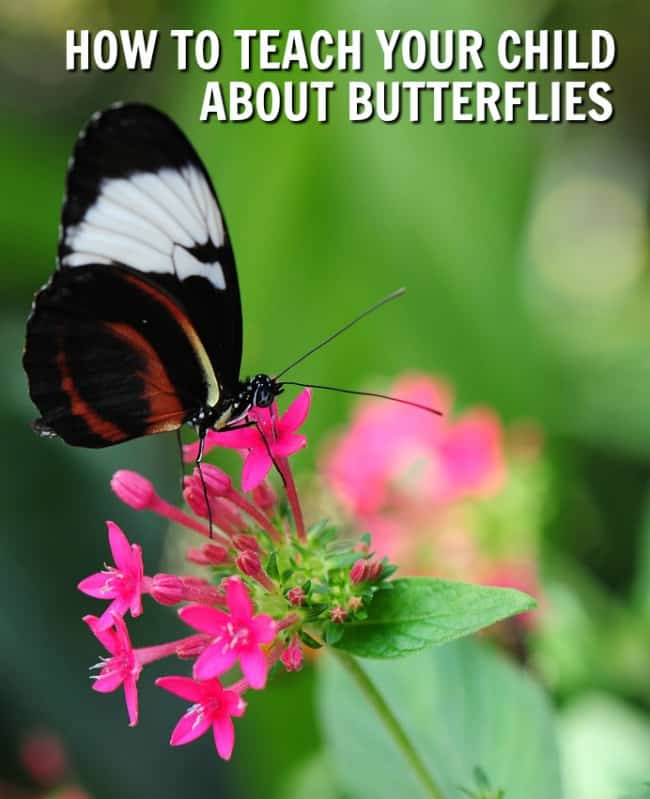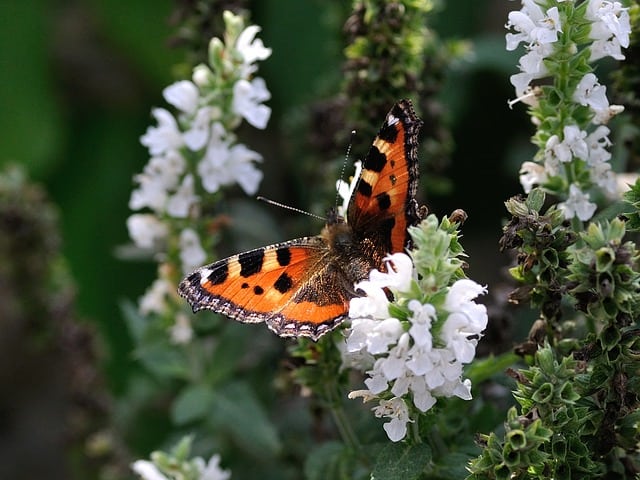Last Updated on April 20, 2023 by ellen
Have you ever wondered how to teach your child about butterflies? I’ve always been fascinated by butterflies and years ago, we took the kids to a butterfly museum. I loved watching them fly around and land on the flowers. They even landed on us a few times which was really neat.
Posts may be sponsored. This post contains affiliate links, which means I will make a commission at no extra cost to you should you click through and make a purchase. As an Amazon Associate I earn from qualifying purchases.

Teach Your Child About Butterflies
Have you ever thought about becoming a butterfly watcher? Erin Gettler – author of the just released Bird Watcher’s Digest Butterflies Backyard Guide – says the hobby is picking up steam. Birders are natural converts – but Gettler insists butterfly watching allows for younger enthusiasts. “Children instinctively understand the fascination – the big flashy wings, the squishy wiggly caterpillars. They get it.”
Without much thought, children are adept at tracking the quick darting of the butterfly. Gettler wants us all to take a step back in time and experience what she believes is the “most accessible entry to the natural world.”
Butterfly watching – “Not as silly as it sounds!” she says. Wizardry on earth – most children would agree. The practice of following a butterfly with bare eyes is a trained talent – but Gettler insists sharp peripheral vision and recognition of small movement is within us.
Here are five ways to teach your child about butterflies.
Learn to recognize five butterfly species, and then get out to see them
This year, meet your neighbors! Learn the names of five of your local common butterfly species, and challenge yourself to find them this spring. Eastern and Western Tiger Swallowtails are big and beautiful, for example, and easy to find in the blooming spring woods. Find Spring Azures by puddles, and admire their iridescent blues when they open their wings to bask in the warm sunshine.

Add native plants
The Perennial Plant Association chose butterfly weed (Asclepias tuberosa) as its perennial plant of the year, a gorgeous, nectar-filled native that attracts dozens of butterflies and feeds monarch butterfly caterpillars. There are options for every taste and habitat! Think about adding a few to your garden.
Go on a butterfly walk with an expert
Next, check events listings for nearby nature centers, arboretums, and public gardens, or natural history groups like the Sierra Club or Audubon Society. Not only will you learn a ton and meet great people, you’ll likely be introduced to more butterfly species and new habitats than you might discover on your own.
Raise a caterpillar, and share the experience with others
Now, if you’re growing native plants already, you might come across a tiny egg or caterpillar making a home in your garden. Why not bring it inside and watch it grow up? The kids in your life—even the kids-at-heart—will love watching along with you! This is a great time to break out those nature activity books.
Write a letter or email to your local government representatives asking what they’re doing to protect butterfly and pollinator habitat in your town
Let your representatives know you care about butterflies and pollinators and ask that they do the same. Now, if you find out nothing’s in the works yet, suggest that roadway medians and verges be left unmown or reseeded with native plants, lowering the cost of maintenance and putting wildlife habitat back into operation. And, support land trusts and conservancies committed to preserving existing habitat in your area.
Butterflies Backyard Guide allows hobbyists to recognize the different groups of butterflies, from blues to sulphurs to commas to skippers. Teach yourself to recognize ten butterflies from your area and the hobby takes on life and wonder. “The trick is to keep looking!” says Gettler.
My thoughts:
So, I love being able to identify different butterflies I see in the garden. The Butterflies Backyard Guide is a handy reference book that lets me identify butterflies and learn how to attract each one. Each butterfly page has a full-color photograph along with information on where to find them, how to identify them, how to attract them, and what their lifecycle is. And, many of them also have a photograph of what their caterpillar version looks like. I had no idea that there were this many different types of butterflies.
Why not make this cute butterfly craft.
Now, if you’d like to teach your child about butterflies, this is the book you need.

Ellen is a mom of a 25-year-old son and 30-year-old daughter. She is Grandma to one adorable toddler. In what little spare time she has, she loves to read, watch movies, and check out the latest toys and games.
Wow…this sounds wonderful and would be an excellent stress-busting activity. Spending time in nature is a natural stress reliever, and focusing on the beautiful butterflies would be oh so relaxing. I’m adding this to my list of stress management activities right now. 🙂
It definitely is a great way to get rid of stress!
This is really fun! I love to visit the butterfly habitat at Bernheim Forest in Kentucky.
That does sound like a great time!
Great ideas. We get a lot of butterflies because of the flower gardens. I need to plant a butterfly bush again, we left three beautiful ones when we moved.
That certainly would help!
I love butterflies! Thank you for these ways to teach my child about them!!
You’re welcome!